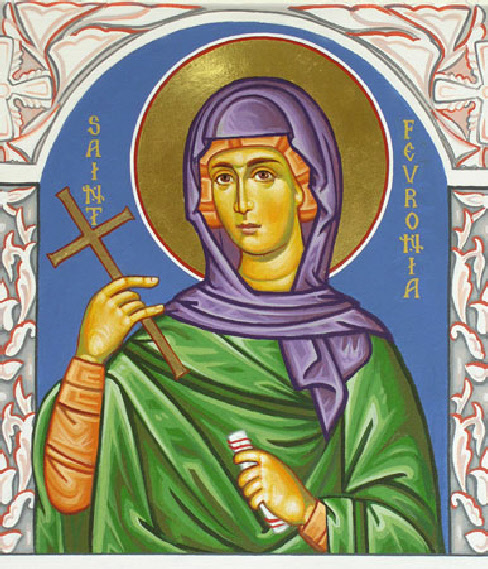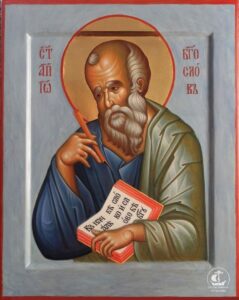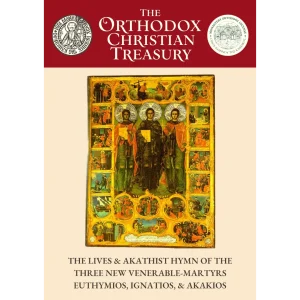Nun-Martyr St. Febronia – Commemorated on June 25

The Virgin-Martyr Febronia suffered during the reign of Diocletian (284-305). She was raised at a monastery in the city of Sivapolis (Assyria region). The head of the women’s monastery was the Abbess Brienna, the aunt of Saint Febronia, and being concerned about the salvation of Saint Febronia, she assigned her a stricter form of life than the other nuns. According to their monastic rule, on Fridays, the sisters left aside their other duties and spent the whole day at prayer and the reading of Holy Scripture, and usually, the abbess appointed the reading to Saint Febronia.
News about her pious life spread throughout the city. The illustrious young widow Hieria, a pagan, began to visit her, and under the influence of her guidance and prayer, she accepted holy Baptism, bringing then to the Christian faith her parents and kinsfolk.
Diocletian dispatched to Assyria for the destruction of Christians a detachment of soldiers under the command of Lysimachus, Selenus, and Primus. Selenos, the uncle of Lysimachus, was noted for his fierce attitude against Christians, but Lysimachus was of a different frame of mind from him, since his mother had sought to inspire love for the Christian faith in her son, and she had died a Christian. And Lysimachus had discussed with his kinsman Primus how far possible it would be to deliver Christians from the hands of the torturer. When the detachment of soldiers approached the convent, its inhabitants hid. There remained only the Abbess Brienna, her helper Thomaida, and Saint Febronia, who at the time was seriously ill. It sorrowed the abbess terribly, that her niece would fall into the hands of the torturers, possibly to defile her, and she prayed fervently that the Lord would preserve her and strengthen her in the confession of Christ the Saviour. Selenus gave orders to bring him all the nuns of the convent. Primus with the detachment of soldiers found no one, except the two old women and Saint Febronia. He regretted that they had not hidden, and he suggested to the nuns to be gone. But the nuns decided not to quit the place of their labours and they entrusted themselves to the will of the Lord.
Primus told Lysimachus about the particular beauty of Saint Febronia and advised him to take her for himself in marriage. Lysimachus answered, that he did not wish to seduce a virgin dedicated to God, and he asked Primus to hide the other nuns somewhere so that they would not fall into the hands of Selenus. One of the soldiers overheard the conversation and told Selenus. They led Saint Febronia off to the military commander with her hands bound and a chain on her neck. Selenus urged her to recant from the faith in Christ and he promised her honours, rewards, and marriage with Lysimachus. The holy virgin firmly and fearlessly answered, that she had the Immortal Bridegroom and she would not exchange Him for some worldly blessing. Selenus subjected her to fierce torture. The saint prayed: “My Saviour, do not abandon me in this terrible hour!” They beat the martyress for a long time, and blood from her handcuffs flowed from the wounds. In order to intensify the suffering of Saint Febronia, they tied her to a tree and set a fire under it. The tortures were so inhuman, that the people began to shout, urging a stop to the torture since there was no confession of guilt by the girl. But Selenus continued to mock and jeer at the martyress. Saint Febronia became silent. Because of weakness, she was unable to utter a word. In a rage Selenus gave orders to tear out her tongue, smash her teeth, and finally, to cut off both hands and legs. The people were unable to bear such a horrid spectacle and they left the scene of the torture, cursing Diocletian and his gods.
Among the crowd was the Nun Thomaida, who afterward recorded in detail the martyr’s act of Saint Febronia, and also her student Hieria. She came forth out of the crowd and in the hearing of all reproached Selenus for his boundless cruelty. He gave orders to arrest her, but learning that Hieria was of illustrious standing whom he could not readily subject to torture, he stopped her, saying: “By thy speech thou hast brought on Febronia yet greater torment”. Finally, they beheaded the holy Martyress Febronia.
Departing the place of execution, Lysimachus wept and withdrew to his quarters. Selenus made ready to eat, but he was not able to take food and went off to the quiet of his own chambers. Suddenly, looking upwards, he all at once lost his speech, bellowed like an ox, fell down, and having struck a marble column, he cracked his head and there he died. When Lysimachus learned of this, he said: “O Great God of the Christians, Who art worthy of respect, in that innocent blood hath been revenged!” He prepared a coffin, placed in it the mutilated body of the martyress, and took it to the convent. Abbess Brienna fell senseless, seeing the mutilated remains of Saint Febronia. By evening time she returned to her senses and gave orders to open the convent gates so that all would be able to come and venerate the holy martyress and glorify God – having given her such endurance in suffering for Christ the Saviour. Lysimachus and Primus thereupon renounced their idol-worship and accepted both Baptism and monasticism. Hieria gave her wealth to the convent and petitioned Abbess Brienna to accept her at the convent in place of Saint Febronia.
Every year, on the day of the martyr’s death of Saint Febronia there was celebrated at the convent a solemn feast. During the time of the all-night vigil, the monastic sisters always saw Saint Febronia, who occupied her usual place in church. From the relics of Saint Febronia occurred numerous miracles and healings. The Life of Saint Febronia was recorded by the Nun Thomaida, an eye-witness to her deeds.
In the year 363, the relics of Saint Febronia were transferred to Constantinople.
Soon after the death of Saint Febronia, Saint James the Bishop of Niziba (Comm. 13 January) built a church and transferred into it part of the relics of the holy martyress.
© 1996-2001 by translator Fr. S. Janos.
ReplyForward






